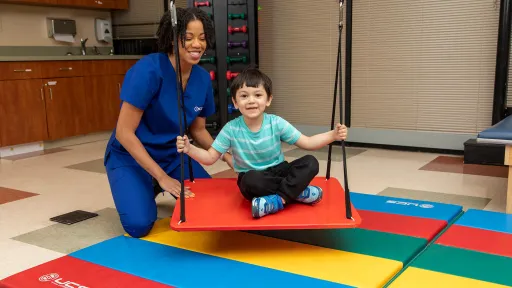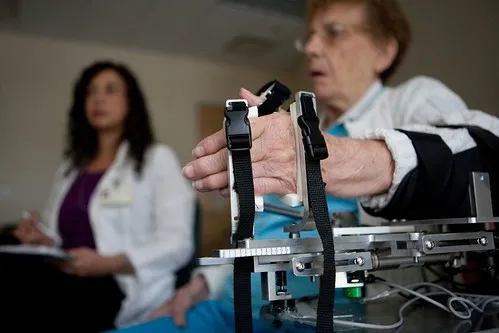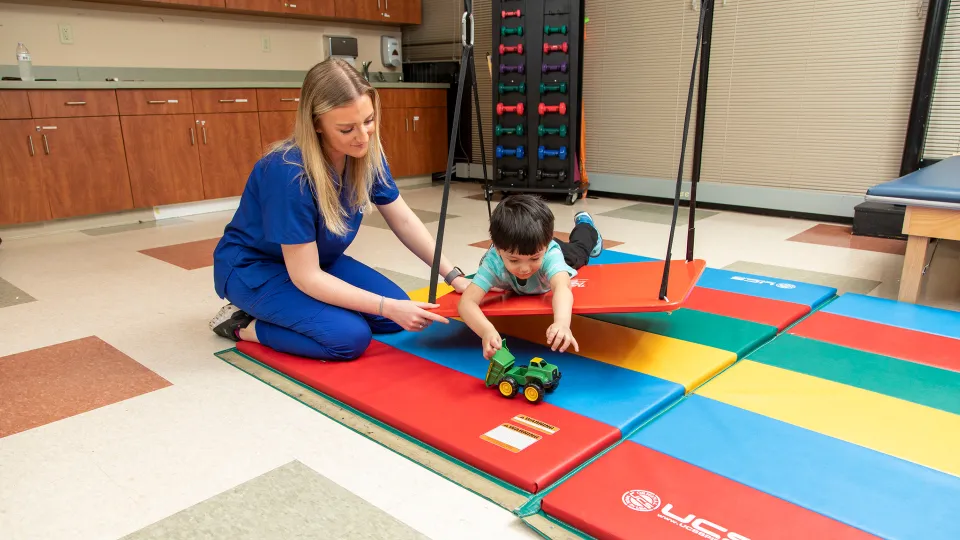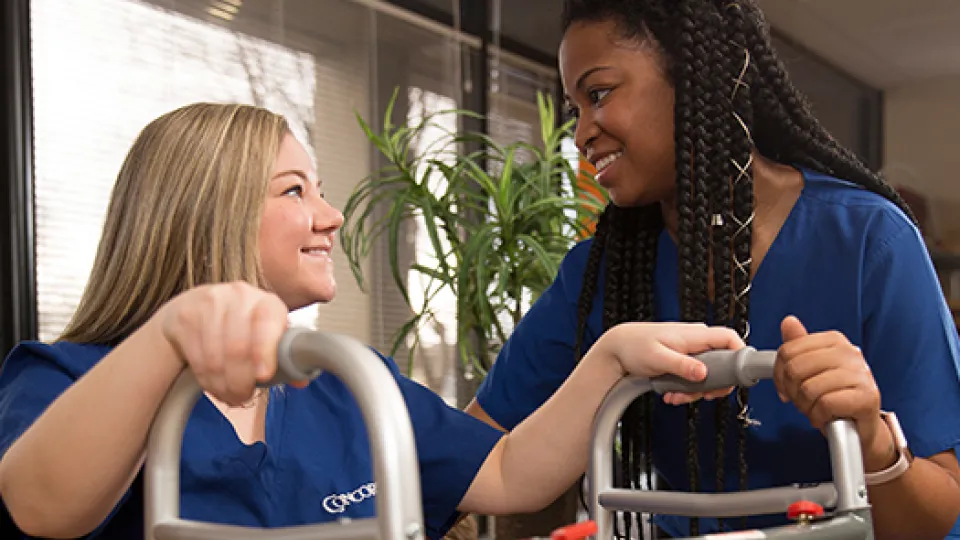
An occupational therapy assistant works alongside occupational therapists to help patients develop, recover, and enhance the skills needed for daily living and working. OTAs assist patients of all ages who are affected by injuries, illnesses, or disabilities, with the goal being to improve their ability to perform everyday tasks and rebuild independence.
OTAs work under the supervision of licensed OTs, following treatment plans tailored to each patient's needs. This allows OTAs to provide support through therapeutic activities, exercises, and equipment training to help patients improve motor functions, cognitive abilities, and self-care skills. As a vital part of the healthcare team, OTAs help improve the quality of life for their patients. This guide outlines what an OTA is and the duties and responsibilities of the occupational therapist assistant role so prospective students can decide if it's a suitable career path for them.
What Is an Occupational Therapist Assistant?
The standard occupational therapy assistant definition is a trained healthcare professional who works under the supervision of an OT to help patients develop, recover, and improve the skills needed for daily living and working. OTAs assist in implementing therapeutic interventions designed to enhance patients' physical, emotional, and social well-being. Their work is crucial in rehabilitation settings, schools, and community health organizations, focusing on enabling individuals to participate in activities that are meaningful to them, whether that involves regaining motor skills, adapting to physical limitations, or improving cognitive function.
Roles and Responsibilities of an OTA
What do occupational therapist assistants do? OTAs work in various healthcare and community environments, such as hospitals, rehabilitation centers, schools, nursing homes, pediatric clinics, and more. OTAs perform a range of duties to support patient care and rehabilitation. Their primary role is to implement treatment plans developed by OTs. This may include the following:
- Assisting patients with therapeutic exercises
- Guiding patients with using adaptive equipment
- Teaching patients techniques for completing daily tasks such as dressing, bathing, or work-related activities
- Monitoring and recording the progress of their patients, ensuring that OTs have updated information to modify treatment plans as needed
- Providing emotional support and encouragement to patients, helping them maintain motivation during their recovery process
Collaboration with occupational therapists is important for adjusting interventions and ensuring that the patient receives comprehensive care tailored to their unique needs.
Related: Why Would Someone Need Occupational Therapy?
Education and Training Requirements

Here are the steps to follow to pursue training as an OTA.
Find an Accredited Program
Accreditation is an important process that ensures educational programs meet specific standards of quality and effectiveness. For OT programs, the Accreditation Council for Occupational Therapy Education is the recognized accrediting body in the United States. ACOTE evaluates and accredits both OT and OTA entry-level programs, ensuring they provide the necessary education and training to prepare graduates for successful careers in the field.
Looking to pursue a career as an OTA? The Occupational Therapy Assistant Associate Degree Program offered by Concorde Career College at the Memphis campus is an ACOTE-accredited program that can be completed in as little as 20 months.
Obtain an Associate Degree
To become an OTA, candidates must complete an ACOTE-accredited associate degree program. These programs typically take about two years to complete and include a combination of coursework and hands-on fieldwork experience. The typical curriculum includes the following:
- Anatomy and physiology
- Psychology
- Occupational therapy principles and practices
- Therapeutic techniques
- Fieldwork education
Get Fieldwork Experience
Fieldwork is a key component of OTA training that provides practical skills. For Level I, each program sets the time requirements for students. For Level II Fieldwork, students need at least 16 weeks of full-time (8 hours) experience or two 8-week rotations under direct supervision for students in an OTA program. Students can complete this full-time or part-time but may not be less than half-time. This hands-on experience is required for graduation and allows students to apply theoretical knowledge in clinical environments, preparing them for professional practice.
Obtain Licensing and Certification
After completing an accredited program, aspiring OTAs must pass the National Board for Certification in Occupational Therapy exam to become licensed, as licensing is mandatory in most states. Passing this exam is typically required for employment as an OTA in most states. Continuing education is often required to maintain certification, ensuring that OTAs stay updated on best practices and advancements in the field. This comprehensive training equips OTAs with the skills necessary to support patients in achieving their therapeutic goals.
Learn more about the Occupational Therapy Assistant Associate of Applied Science Degree Program in Memphis
Where Do Occupational Therapy Assistants Work?

OTAs can work in a variety of healthcare and community environments, where they collaborate with OTs to provide tailored patient care. OTAs may work with diverse populations, including children, adults, and seniors, adapting their approach based on the unique needs of each group. OTAs may work in the following settings:
- Hospitals
- Rehabilitation centers
- Schools
- Nursing homes
- Pediatric clinics
- Home health agencies
- Outpatient clinics
- Community centers
- Mental health facilities
Responsibilities may vary based on the work setting and client needs, but OTAs play a key role in improving patients' daily functioning in each environment.
Related: Where Can Occupational Therapy Assistants Work?
Career Outlook
The job outlook for OTAs is positive, with projected employment growth of 21% from 2023 to 2033, significantly faster than the average for all occupations. The number of jobs is projected to increase by 10,800 in the same term, driven by the rising demand for rehabilitation services as the population ages. While demand may vary by location, OTAs have the opportunity for a stable and rewarding career in the healthcare industry. Prospective OTAs are encouraged to research their local job market for specific opportunities.
Skills and Qualities of Successful OTAs

Successful OTAs possess a blend of technical skills and personal qualities that contribute to effective patient care and collaboration with OTs:
- Compassion and empathy: OTAs must genuinely care for their patients and understand their challenges. This quality helps them build trusting relationships, creating a supportive environment that encourages clients to engage in their therapy.
- Physical stamina: The role often requires standing for long periods, assisting clients with physical activities, and lifting or moving equipment. Good physical stamina ensures OTAs can meet the demands of the job.
- Patience: Many patients may progress slowly or face setbacks. An OTA's patience helps them provide consistent support, allowing patients to work at their own pace and feel understood throughout their recovery journey.
- Attention to detail: OTAs must carefully monitor clients' progress, implement treatment plans accurately, and recognize any changes in their condition. This attention to detail ensures that the care provided is effective and tailored to individual needs.
- Communication: Strong verbal and nonverbal communication skills are essential for OTAs. They must effectively convey instructions, provide feedback, and communicate with clients, families, and the healthcare team for cohesive care.
- Problem-solving: OTAs often encounter unexpected challenges during therapy sessions. Their problem-solving skills allow them to quickly adapt treatment approaches and find solutions to any potential obstacles.
- Adaptability: Patient needs and progress can vary significantly. OTAs must be flexible in adjusting treatment plans and techniques to accommodate changing circumstances and client responses.
- Teamwork: Collaboration with OTs and other healthcare professionals is crucial. OTAs must work effectively as part of a multidisciplinary team, sharing insights and contributing to a comprehensive care plan.
- Creativity: OTAs often need to think outside the box, especially when working with children or seniors. By turning therapeutic tasks into games or engaging activities, they can make the therapy process more enjoyable and motivating.
- Determination: Progress in occupational therapy can sometimes be slow, and patients may feel discouraged. An OTA's determination and persistence help support and encourage patients to be more resilient.
Difference Between OTAs and OTs

There are several key differences between the role of an OTA and an OT, though both roles are closely related:
- Education level: OTs require a master's degree, while OTAs need an associate degree.
- Responsibilities: OTs evaluate patients and create treatment plans, while OTAs implement these plans.
- Supervision: OTAs work under the supervision of OTs.
The collaborative relationship between OTs and OTAs is essential for ensuring effective patient care.
Related: Is Health Care Career Training Right for You?
Advancement Opportunities for OTAs
OTAs have several opportunities for career advancement, including specialization, certification, supervisory roles, and continuing education. Many OTAs choose to specialize in specific areas of practice, pursue additional certifications, or take on leadership or supervisory roles within their workplace. Popular specialization areas can include the following:
- Certified Lymphedema Therapist
- Certified Brain Injury Specialist
- Certified Autism Specialist
- Assistive Technology Professional
- Certified Stroke Rehabilitation Specialist
Lifelong learning is important to succeed in this career. Continuing education is also an option for OTAs who wish to become OTs, providing long-term growth opportunities in the field. Concorde's Occupational Therapy Assistant Program prepares students for a career as an OTA. Those interested in becoming an OT would need to pursue additional education and meet specific requirements.
Take the Next Step Today
A career as an OTA offers the chance to have a meaningful impact on patients' lives, helping them regain their independence and the ability to perform daily tasks. With a growing job market, diverse work settings, and opportunities for advancement, this role is ideal for students with the necessary technical skills and personal qualities. Whether you're drawn to working with children, seniors, or specialized populations, training to become an OTA could be the ideal path to a rewarding healthcare career. Contact our admissions team for more information on the Occupational Therapy Assistant Associate Degree Program at Concorde.
U.S. Bureau Of Labor Statistics. (2019, September 4). Occupational Therapy Assistants and Aides : Occupational Outlook Handbook: : U.S. Bureau of Labor Statistics. Bls.gov. https://www.bls.gov/ooh/healthcare/occupational-therapy-assistants-and-aides.htm
Take The Next Step Towards a Brighter Future
Interested in learning more about our Occupational Therapy Assistant program?
We have a Concorde representative ready to talk about what matters most to you. Get answers about start dates, curriculum, financial aid, scholarships and more!







